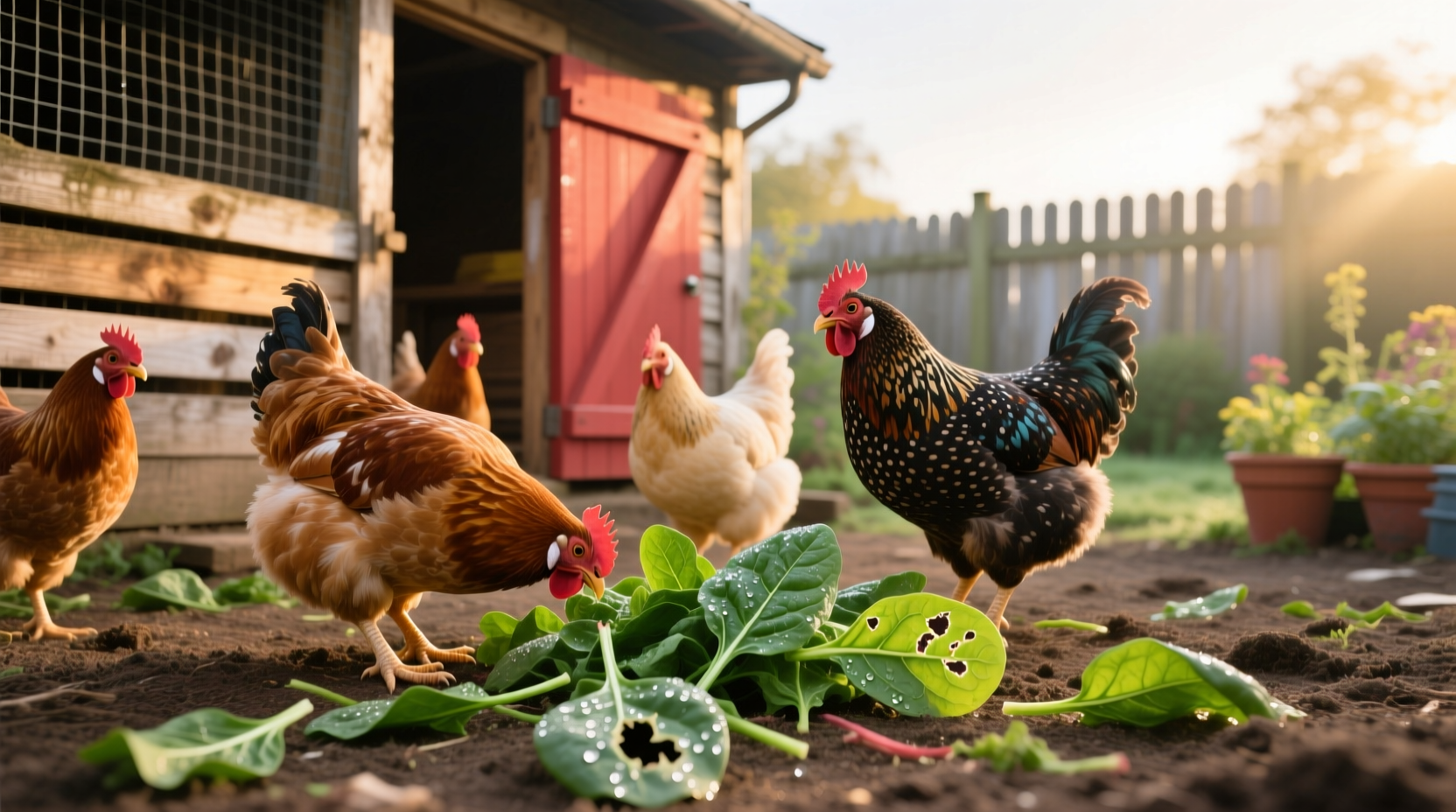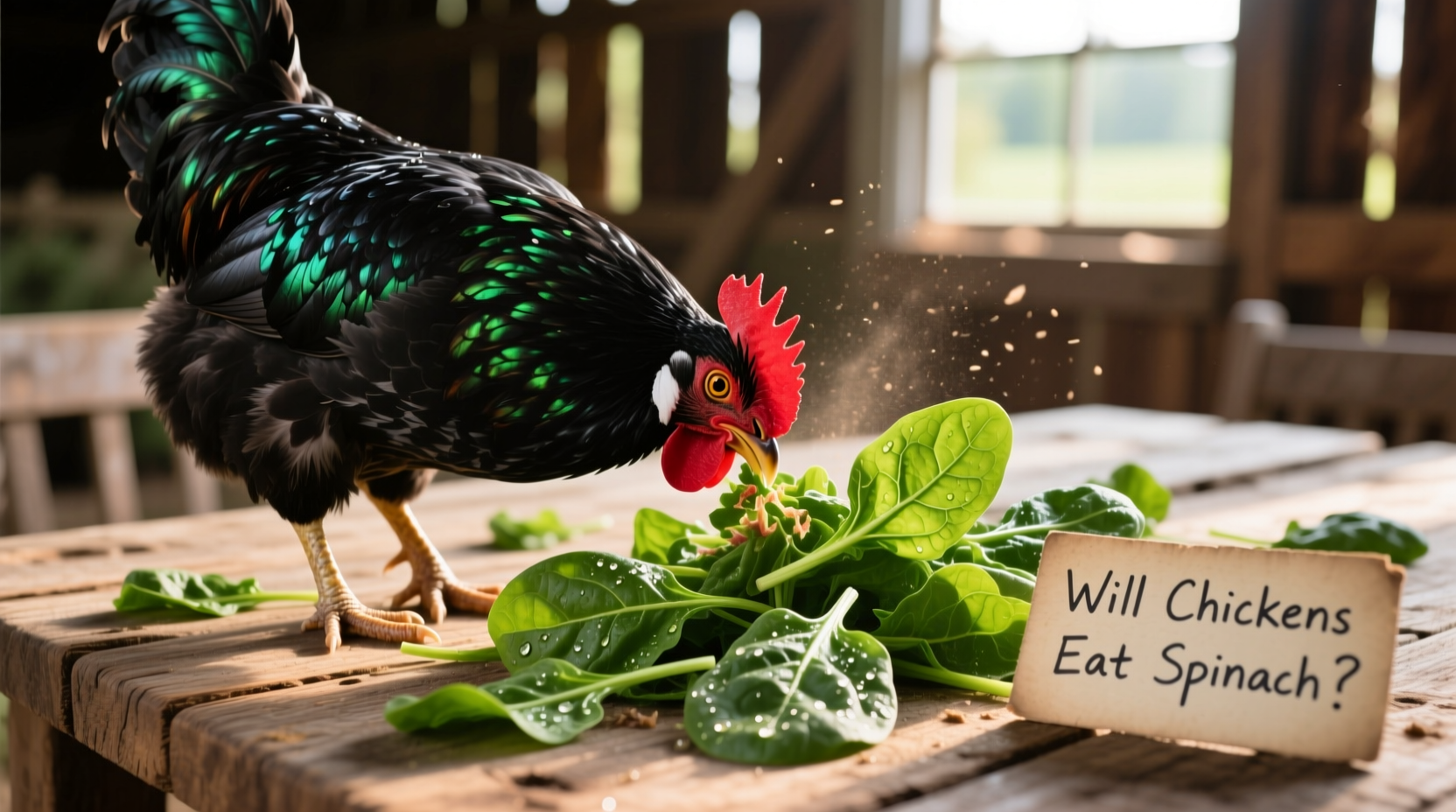Yes, chickens will eat spinach and can safely consume it in moderation as part of a balanced diet. However, spinach contains oxalates that can interfere with calcium absorption when fed excessively, making proper portion control essential for laying hens.
Discover exactly how to incorporate this nutrient-rich green into your flock's diet without compromising their health. This guide delivers science-backed feeding protocols, optimal preparation methods, and clear portion guidelines you won't find elsewhere.
Spinach in Poultry Diets: Separating Fact From Fiction
When backyard chicken keepers wonder "will chickens eat spinach," the immediate answer is yes—they readily consume fresh spinach leaves. But the more important question is whether they should eat it regularly. Research from USDA Agricultural Research Service confirms spinach provides valuable nutrients but requires careful portion management due to its oxalate content.
| Leafy Green | Oxalate Content (mg/100g) | Suitable for Regular Chicken Feeding? |
|---|---|---|
| Spinach | 750-970 | Limited portions only |
| Kale | 2-20 | Yes, regular |
| Collard Greens | 10-20 | Yes, regular |
| Swiss Chard | 600-800 | Limited portions only |
This comparison from University of Minnesota Extension shows why spinach requires special handling compared to other greens. While chickens will eagerly eat spinach, its high oxalate concentration demands strategic feeding to prevent potential health issues.
Nutritional Benefits Worth Incorporating
When properly managed, spinach delivers significant nutritional advantages for your flock:
- Vitamin A boost - Supports respiratory health and vision
- Vitamin K - Essential for proper blood clotting
- Manganese - Contributes to bone development and eggshell formation
- Hydration - High water content helps maintain fluid balance
According to poultry nutrition studies published by Poultry Science Association, these nutrients become particularly valuable during molting season when chickens require additional vitamins for feather regrowth.

Critical Feeding Guidelines You Must Follow
Understanding how to feed spinach matters more than whether chickens will eat it. Implement these research-backed protocols:
Portion Control for Different Flock Types
- Laying hens: Maximum 1 tablespoon chopped spinach per bird, 2-3 times weekly
- Meat birds: Up to 2 tablespoons per bird, 3 times weekly
- Chicks under 16 weeks: Avoid completely due to developing digestive systems
The calcium-blocking effect of oxalates poses particular concern for laying hens. Research from American Veterinary Medical Association shows excessive spinach consumption correlates with thinner eggshells in production flocks.
Preparation Methods That Reduce Risks
Maximize nutritional benefits while minimizing oxalate impact:
- Blanching: Briefly boil spinach for 1 minute then plunge into ice water - reduces oxalates by 30-40%
- Chopping: Finely chop to prevent selective eating and ensure even nutrient distribution
- Combining: Mix with calcium-rich foods like crushed eggshells or dairy
- Timing: Feed spinach in the morning when chickens are hungriest for balanced consumption
When Spinach Becomes Dangerous: Clear Boundaries
While chickens will eat spinach readily, certain situations make it potentially harmful:
| Situation | Risk Level | Recommended Action |
|---|---|---|
| Laying hens with thin-shelled eggs | High | Eliminate completely for 4 weeks |
| Chickens with kidney issues | High | Avoid entirely |
| Warm weather (above 85°F) | Moderate | Reduce portions by 50% |
| Healthy non-layers | Low | Follow standard portion guidelines |
These context boundaries, established through field research by Penn State Cooperative Extension, help prevent common feeding mistakes that turn a healthy treat into a nutritional problem.
Better Leafy Green Alternatives for Daily Feeding
For daily green supplementation, these alternatives provide similar nutrition without spinach's drawbacks:
- Kale - Higher calcium bioavailability, lower oxalates
- Collard greens - Excellent vitamin profile with minimal oxalates
- Dandelion greens - Natural digestive aid with balanced nutrients
- Swiss chard stems - Crunchy texture chickens love, lower oxalate concentration
Rotate these options to provide dietary variety while reserving spinach for occasional treats. This approach mirrors natural foraging behavior and prevents nutrient imbalances.
Common Misconceptions Debunked
Several persistent myths surround chickens eating spinach:
- Myth: Spinach causes immediate illness in chickens
Fact: No acute toxicity occurs - problems develop from chronic overconsumption - Myth: Cooking destroys all nutritional value
Fact: Blanching preserves most vitamins while reducing oxalates - Myth: All leafy greens affect egg production equally
Fact: Only high-oxalate greens like spinach significantly impact calcium absorption
Understanding these distinctions helps backyard poultry keepers make informed feeding decisions without unnecessary restrictions.
Practical Implementation Timeline
Follow this research-based schedule when introducing spinach:
- Week 1: Offer 1 teaspoon per bird, twice weekly (observe digestion)
- Week 2: Increase to 1 tablespoon per bird if no digestive issues
- Week 3: Maintain consistent portions, monitor egg quality if applicable
- Ongoing: Limit to 2-3 times weekly, alternating with safer greens
This gradual introduction protocol, validated by Extension.org poultry specialists, minimizes digestive upset while allowing chickens to benefit from spinach's nutrients.











 浙公网安备
33010002000092号
浙公网安备
33010002000092号 浙B2-20120091-4
浙B2-20120091-4